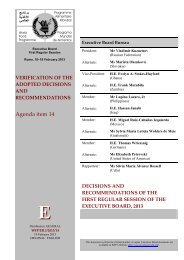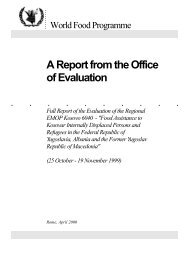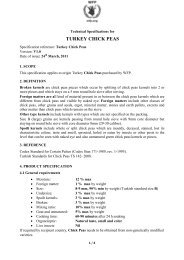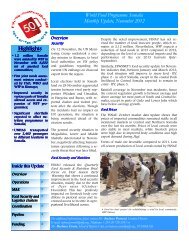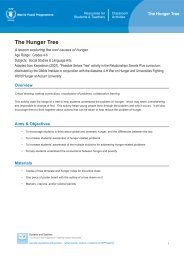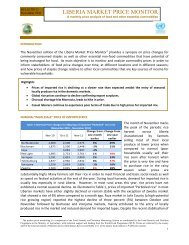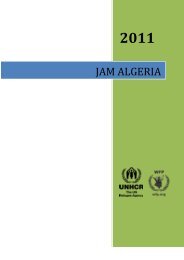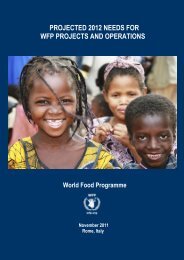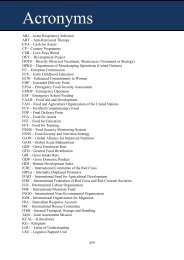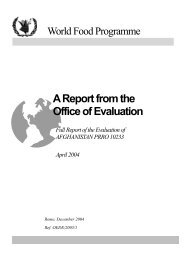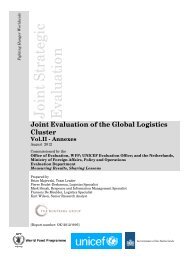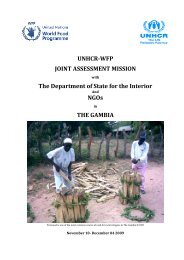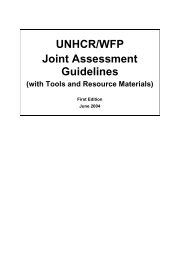The Potential for Scale and Sustainability in Weather Index Insurance
The Potential for Scale and Sustainability in Weather Index Insurance
The Potential for Scale and Sustainability in Weather Index Insurance
You also want an ePaper? Increase the reach of your titles
YUMPU automatically turns print PDFs into web optimized ePapers that Google loves.
THE POTENTIAL FOR SCALE AND SUSTAINABILITY IN WEATHER INDEX INSURANCE<br />
FOR AGRICULTURE AND RURAL LIVELIHOODS<br />
Chapter 2<br />
<strong>Weather</strong> <strong>in</strong>dex-based<br />
<strong>in</strong>surance<br />
<strong>The</strong> concept of <strong>in</strong>dex <strong>in</strong>surance is not new. 4 Proposals <strong>for</strong> this type of <strong>in</strong>surance were<br />
first articulated by Halcrow (1948) <strong>and</strong> D<strong>and</strong>ekar (1977), <strong>and</strong> area-yield <strong>in</strong>surance<br />
has been tried on a heavily subsidized basis <strong>in</strong> Canada, India, Sweden <strong>and</strong> the United<br />
States (Mir<strong>and</strong>a 1991; Mishra 1996; Skees, Black <strong>and</strong> Barnett 1997). <strong>The</strong> Australian<br />
Government commissioned a feasibility study of ra<strong>in</strong>fall <strong>in</strong>surance <strong>in</strong> the mid-1980s,<br />
but decided not to pursue it (IAC 1986).<br />
<strong>Index</strong> <strong>in</strong>surance is a f<strong>in</strong>ancial product l<strong>in</strong>ked to an <strong>in</strong>dex highly correlated to local<br />
yields. Contracts are written aga<strong>in</strong>st specific perils or events (e.g. area yield loss,<br />
drought, hurricane, flood) that are def<strong>in</strong>ed <strong>and</strong> recorded at regional levels (e.g. at a<br />
local weather station). Indemnifications are triggered by pre-specified patterns of the<br />
<strong>in</strong>dex, as opposed to actual yields, which elim<strong>in</strong>ates the need <strong>for</strong> <strong>in</strong>-field assessments.<br />
In addition, because the <strong>in</strong>surance product is based on an <strong>in</strong>dependently verifiable<br />
<strong>in</strong>dex, it can be re<strong>in</strong>sured, thus allow<strong>in</strong>g <strong>in</strong>surance companies to transfer part of their<br />
risk to <strong>in</strong>ternational markets.<br />
All buyers <strong>in</strong> the same region are offered the same contract terms per dollar of<br />
<strong>in</strong>surance coverage. That is, they pay the same rate of premium <strong>and</strong>, once an event has<br />
triggered payouts, receive the same rate of payout; their total payout depends on the<br />
value of the <strong>in</strong>surance coverage purchased. Payouts can be structured <strong>in</strong> a variety of<br />
ways, rang<strong>in</strong>g from a simple zero/one contract (i.e. once the threshold is crossed, the<br />
payment rate is 100 per cent), through a layered payment schedule (e.g. a one-third<br />
payment rate as different thresholds are crossed), to a proportional payment schedule.<br />
<strong>The</strong>re are several advantages to <strong>in</strong>dex <strong>in</strong>surance. S<strong>in</strong>ce all buyers of the same<br />
contract pay the same premium <strong>and</strong> receive the same <strong>in</strong>demnity per unit of <strong>in</strong>surance,<br />
regardless of their actions, <strong>in</strong>dex <strong>in</strong>surance avoids the problems of adverse selection<br />
<strong>and</strong> moral hazard. Thus a farmer with ra<strong>in</strong>fall <strong>in</strong>surance possesses the same economic<br />
<strong>in</strong>centives to manage her crop as an un<strong>in</strong>sured farmer.<br />
Once established, <strong>in</strong>dex <strong>in</strong>surance can be less expensive to adm<strong>in</strong>ister than<br />
traditional agricultural <strong>in</strong>surance, because there are no on-site <strong>in</strong>spections or <strong>in</strong>dividual<br />
loss assessments to per<strong>for</strong>m. It uses only the data of a regional <strong>in</strong>dex, which can be<br />
based on data that are available <strong>and</strong> generally reliable. At the extreme, contracts could<br />
4 This paper focuses on the use of weather <strong>in</strong>dex-based <strong>in</strong>surance, but will also use the term ‘<strong>in</strong>dex <strong>in</strong>surance’ <strong>for</strong><br />
the sake of simplicity <strong>and</strong> brevity.<br />
21



